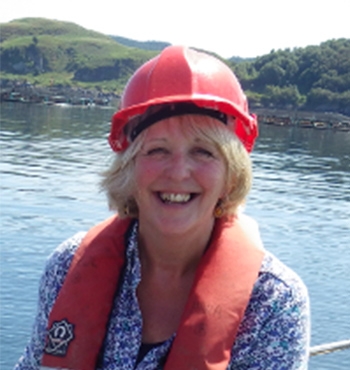I am a marine biologist with practical and academic experience providing technical support on a variety of projects in both research and enterprise activity involving intertidal rocky shore, laboratory and boat work. The logistics of working on numerous projects, across various disciplines, within different time frameworks requires excellent time management, planning and organisational skills. This role requires not only good knowledge of laboratory, boat and field survey procedures and safe working practises but also good communication skills and establishing and maintaining positive relationships with fellow staff, students and external bodies. New projects often require learning a new set of skills and have their own challenges and rewards.
Kerrison, P., Twigg, G., Stanley, M., De Smet, D., Buyle, G., Martínez Pina , A. & Hughes, A. (2019). Twine selection is essential for successful hatchery cultivation of Saccharine Latissima, seeded with either meiospore or juvenile sporophytes. Journal of Applied Phycology https://doi.org/10.1007/s10811-019-01793-x
Twigg G.C. & Hughes A.D. (2018). Use of Seaweed in Finfish Diets. Currently under review in Aquaculture Journal.
Kerrison P.D., Le H.N., Twigg G.C., Smallman D.R., MacPhee R., Houston F.A.B., Hughes A.D. (2016). Decontamination treatments to eliminate problem biota from macroalgal tank cultures of Osmundea pinnatifida, Palmaria palmata and Ulva lactuca. Kerrison, Journal of Applied Phycology 28: 3423-3434
Cook E.J., Beveridge C., Twigg G., Macleod A. (2014). Assessing the Effectiveness of Early Warning Systems for the Detection of Marine Invasive Non-Native Species in Scottish Waters. Scottish Natural Heritage Commissioned Report No. 874.
Twigg G.C. (2011) Fucus distichus L. and related species in the British Isles in relation to sea temperature change. PhD Thesis, Department of Biological Sciences, Heriot-Watt University, Edinburgh. pp. 216
Reports
Twigg G. C. (2016) Marine Natural Products, Terpenoids and Legislation in Algae, Review on Terpenoids for final S3EED report.
Twigg G, Hughes A, Kerrison PD (2014). Determining the optimal nutrient regime for the cultivation of Palmaria palmata, Ulva lactuca, Osmundea pinnatifida and Chondrus crispus 11.
Twigg G, Hughes A, Kerrison PD (2014). M1.2 B2: Optimal light:dark regime for the cultivation of Palmaria palmata, Ulva lactuca, Osmundea pinnatifida, Chondrus crispus and Mastocarpus stellatus, pp.4.
Twigg G, Hughes A, Kerrison PD (2014). M1.2 B3: Light:dark regime testing with uncontrolled temperature fluctuations in Palmaria palmata, Ulva lactuca, Osmundea pinnatifida and Mastocarpus stellatus, pp.12.
Twigg G, Hughes A, Kerrison PD (2014). M1.2 B4: The effect of light intensity on the growth of Osmundea pinnatifida and Chondrus crispus, pp.3.
Twigg G, Beattie S, Hughes A, Kerrison PD (2014). M1.2 B5: Palmaria cutting treatments to investigate growth in Palmaria palmata, pp. 5.
SNH Commissioned Reports: Mousa, Shetland Isles 2008 326; Isle of May, Firth of Forth 2007 No. 301; Treshnish Isles, Inner Hebrides 2007 No. 302; Loch Maddy, North Uist, Outer Hebrides 2006 No. 152.
MarClim20s: The aim of this project is to detect ongoing changes in the biota of intertidal rocky shores around Scotland by conducting biogeographical surveys. The primary goal is to collect data that can detect change relative to earlier surveys and form the basis for any future reference.
CoastFrag: looking at the impact of habitat fragmentation and loss on coastal ecosystems: implications for sustainable management under climate change. This requires sampling rocky shores under different levels of wave exposure and nutrient loading.
BactMetBar: Monthly sediment sampling at local fish farm to carry out environmental DNA metabarcoding of microbial communities to indicate the benthic footprint of salmon farming.
BEF-SCALE: The overall aim of this project is to bridge this gap by determining how biodiversity's functional role changes with increasing spatial scale and environmental dimensionality (variation in different environmental factors), ultimately developing continuous and predictive scaling of BEF relationships.
NITRO Fellow: This work package will build and operate protein production, bioremediation and energy generation system in collaboration with an industrial partner operating a marine finfish RAS in Scotland. This integrated system is designed to be scalable and transferable to a range of different industries and align with current priorities to promote nutrient recycling and encourage value-addition of waste streams.
Upcycle’N: The project will upcycle waste in situ through a two-stage biological remediation system, thereby reducing point-source discharge of pollutants to water bodies and GHG emissions from transport and spreading of waste to agricultural land. The overall objective is of future-proofing the Scottish aquaculture industry by providing more sustainable and climate-friendly technologies to deal with organic waste.
Holo Sea Lice: This project involves working with engineers from Aberdeen University to test their holographic camera for finding, identifying, and quantifying sea lice larvae.
Fieldwork experience
Intertidal rocky shore surveys, boat work including grab sampling.
Relevant training course/qualifications achieved
Benthic grab survey deployment, Personal Survival Techniques,
Outreach experience / qualifications
STEMS Day 25/04/2022
Show and tell at the OEC for groups of primary school children from the local area.
Blue BioTech Module
Take visiting students on an intertidal rocky shore excursion. Will show and explain zonation patterns on the shore and how that zonation affects the plants and animals that live on it.
H2 Marine Biology rocky shore survey
Students will be taught how to carry out a rocky shore survey using transects and quadrats to quantify the shore. Also demonstrate the use of levelling equipment to produce rocky shore profiles.
IDCORE-Environment
Marine engineering students from the University of Edinburgh come to learn about the marine environment and interactions with offshore renewables. I am part of the intertidal ecology excursion team.
